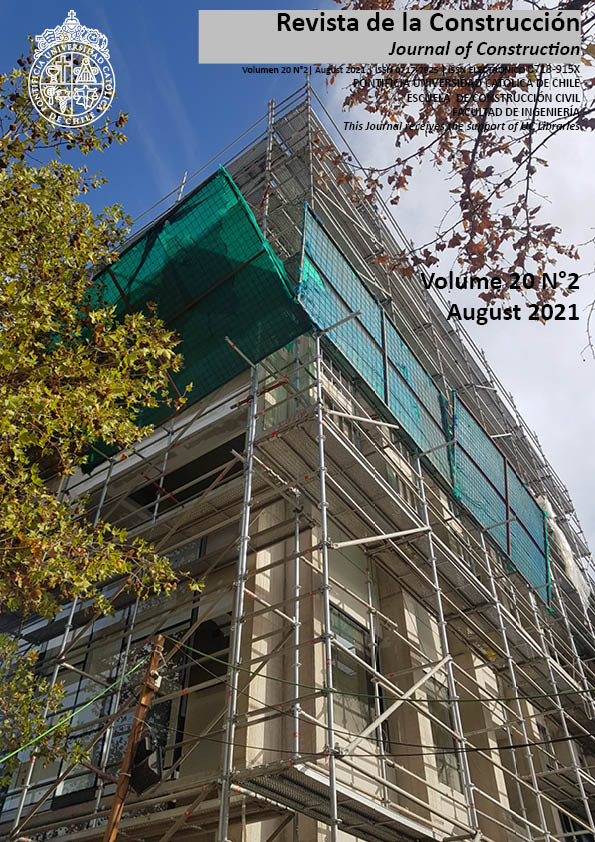Mechanical properties of roller compacted concrete containing recycled concrete aggregate
DOI:
https://doi.org/10.7764/RDLC.20.2.277Keywords:
recycled aggregate, cement dosages, optimum water content, mechanical properties, roller compacted concreteAbstract
The compressive strength, splitting tensile strength, pulse velocity, and drop weight impact resistance of roller-compacted concrete (RCC) mixtures containing recycled concrete aggregate (RCA) were investigated. The cement contents of the RCC mixtures were chosen as 150, 200 and 250 kg/m3. In addition to the control mixtures containing no RCA, 25, 50, 75, and 100 wt% of the crushed limestone aggregate was replaced with RCA. In this way, 15 RCC mixtures were prepared. The water content of RCC mixtures was determined by the maximum density method. The results showed that increasing the amount of recycled aggregate decreased the mechanical properties of the concrete. However, up to 25% replacement level, recycled aggregate had not a significant detrimental effect on the properties of RCC. Besides, the detrimental effect of RCA substitution was more pronounced in leaner mixtures and reduced by increasing the cement content of the RCC.
Downloads
References
ACI 207.5R-99. Roller-compacted mass concrete. Reported by ACI Committee 207; 1988.
ACI Committee 544, 1988, Design Considerations for Steel Fiber Reinforced Concrete, ACI Structural Journal, 563-580.
ASTM C 597. Standard test method for pulse velocity through concrete. Annual Book of ASTM Standards. Philadelphia, PA, USA: American Society of Testing Materials; 2002.
Courard, L., Michel, F., & Delhez, P. (2010). Use of concrete road recycled aggregates for roller compacted concrete. Construction and Building Materials, 24(3), 390-395.
Debieb, F., Courard, L., Kenai, S., & Degeimbre, R. (2009). Roller compacted concrete with contaminated recycled aggregates. Construction and Building Materials, 23(11), 3382-3387.
EN 12390-3. Concrete testing-hardened concrete – Part 3: Compressive strength test samples. Brussels: European Standard; 2010.
EN 12390-6. Concrete: Testing-hardened concrete – Part 3: split tensile strength test samples. Brussels: European Standard; 2010.
Etxeberria, M., Vázquez, E., Marí, A., & Barra, M. (2007). Influence of amount of recycled coarse aggregates and production process on properties of recycled aggregate concrete. Cement and Concrete Research, 37(5), 735-742.
Fakhri, M. (2016). The effect of waste rubber particles and silica fume on the mechanical properties of roller compacted concrete pavement. Journal of Cleaner Production, 129, 521-530.
Gürer, C., Akbulut, H., & Kürklü, G. (2004, May). Recycling and re-evaluation of different building materials as a source of raw material in the construction industry. In 5th Industrial Raw Materials Symposium (Vol. 1314).
Jalilifar, H., Sajedi, F., & Toosi, V. R. (2020). Evaluating the durability of recycled concrete made of coarse recycled aggregate concrete containing silica-fume and natural zeolite. Revista de la Construcción. Journal of Construction, 19(3), 457-473.
LaHucik, J., Dahal, S., Roesler, J., & Amirkhanian, A. N. (2017). Mechanical properties of roller-compacted concrete with macro-fibers. Construction and Building Materials, 135, 440-446.
Lopez-Uceda, A., Agrela, F., Cabrera, M., Ayuso, J., & López, M. (2018). Mechanical performance of roller compacted concrete with recycled concrete aggregates. Road Materials and Pavement Design, 19(1), 36-55.
Meddah, A., Beddar, M., & Bali, A. (2014). Use of shredded rubber tire aggregates for roller compacted concrete pavement. Journal of Cleaner Production, 72, 187-192.
Modarres, A., & Hosseini, Z. (2014). Mechanical properties of roller compacted concrete containing rice husk ash with original and recycled asphalt pavement material. Materials and Design, 64, 227-236.
Muscalu, M. T., & Andrei, R. (2011). Use of recycled aggregates in rigid pavement construction. Buletinul Institutului Politehnic din lasi. Sectia Constructii, Arhitectura, 57(2), 69.
Neville A. M. Concrete technology. 2nd ed. UK: Longman; 2010.
Paul, S. C., & Van Zijl, G. P. A. G. (2013). Mechanical and durability properties of recycled concrete aggregate for normal strength structural concrete. International Journal of Sustainable Construction Engineering and Technology, 4(1), 89-103.
Peng, G. F., Huang, Y. Z., Wang, H. S., Zhang, J. F., & Liu, Q. B. (2013). Mechanical properties of recycled aggregate concrete at low and high water/binder ratios. Advances in Materials Science and Engineering, 2013.
Philleo, R. E. (1955, January). Comparison of results of three methods for determining Young’s modulus of elasticity of concrete. In Journal Proceedings (Vol. 51, No. 1, pp. 461-470).
Rao, M. C., Bhattacharyya, S. K., & Barai, S. V. (2011). Behaviour of recycled aggregate concrete under drop weight impact load. Construction and Building Materials, 25(1), 69-80.
Settari, C., Debieb, F., Kadri, E. H., & Boukendakdji, O. (2015). Assessing the effects of recycled asphalt pavement materials on the performance of roller-compacted concrete. Construction and Building Materials, 101, 617-621.
Sonawane, T. R., & Pimplikar, S. S. (2013). Use of recycled aggregate concrete. IOSR Journal of Mechanical and Civil Engineering, 52, 59.
Whitehurst, E. A. (1951, February). Soniscope tests concrete structures. In Journal Proceedings (Vol. 47, No. 2, pp. 433-444).








